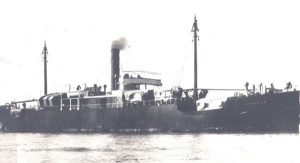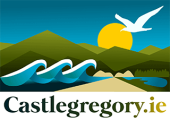 A Rising tide at Illauntannig
A Rising tide at Illauntannig
by Mr Dan McCarthy, Irish Examiner Newspaper. Published 27/11/2017
The date: Holy Thursday, 1916. A German ship lies anchored between the two tiny islands of Illaunimmil and Inishtooskert off Castlegregory in north Kerry. Its cargo, a Shipment of arms arranged by rebel leader Roger Casement to be distributed in the southwest of the country with the ultimate aim of aiding the Rising in Dublin against British rule. The course of Irish history depends on its success. Watching out for the arrival of the ship from another of the Seven Hogs, llauntannig (O’Leary’s Island), was a young Volunteer of Castlegregory Company IV, Mortimer O’Leary who lived with his family on the island. His instructions from his company captain Tadg Brosnan were to guide the ship into Fenit. On the Holy Thursday night a two-masted, 3,000 ton steamer arrived. Mortimer had been told to watch out for a lighter of around 150 tons. In a testimony in the 1950s Mortimer recalled: “I watched her from the back window from nightfall until 12 midnight. I did not see her make any signal during that time”.The ship that had arrived that Mortimer didn’t recognise was in fact the Aud. It had arrived early. On the Friday morning a British destroyer arrived and the Aud attempted to escape. On the approach to Cork Harbour the ship was scuttled. On the Saturday night over 300 Volunteers assembled in Kerry and marched through inclement conditions through the night. They had arrived in Tralee by the Sunday morning. Following the failure to land the arms from the Aud, the arrest of Casement and Volunteer leader Austin Stack, word filtered through to the rebels that the southern uprising was to be abandoned. The Rising went ahead in Dublin as planned. The Aud mission ultimately failed through lack of communication. History may have turned out very differently if Captain Karl Spindler, anchored between the two tiny Kerry islands of Illaunimmil and Inishtooskert had had a radio. On the Sunday morning a detachment of RIC arrived on Illauntannig and arrested two people on suspicion of being involved in the attempted landing of the Aud.“If she had hoisted her jack … any pilot would have taken her into Fenit without question. Friday night was a fine moonlight night and I could have taken her into Fenit without the least difficulty. She was in the bay almost exactly 24 hours,” said Mortimer. A final twist: Casement was attempting to call off the Rising not support it due to insufficient arms.The other islands in the Seven Hogs archipelago are Gurrig Island, Illaunboe, Illaunturlogh and Mucklaghbeg Island. They form what is known in geographical terminology as a tombolo – an island or group of islands connected to the mainland by a sandspit or rocky promontory. The mainland in this instance is the Maharees, derived from Oileáin an Mhachaire. The Maharees is a scimitar of rock whose magnificent sandy beaches slice into Tralee Bay. The area is a major tourist centre with beautiful walks, birdwatching sites, sea sports, and camping.
Illauntannig is the largest and had a population of 22 hardy souls in 1891. With good grazing, cattle were obliged to swim across from Scraggane Pier 1km away. This island had a small monastery founded by St Seannach in the sixth century. Within its thick cashel (surrounding wall) there are three beehive huts and two oratories and a Celtic cross nearly two metres in height. St Seannach was the brother of St Senan who founded the monastery on Scattery Island Co Clare, just up the coast. The other islands in the group were likely never inhabited. Their best use appears to be for sheep grazing. Nonetheless, they are strikingly beautiful in their own right: a carpet of daisies on the indented Illaunturlogh; a gentle beach on Reenfardarrig; the isolation of Gurrig.
Selected Reading:-
Tans, Terror and Troubles: Kerry’s Real Fighting Story 1913-1923, Ryle Dwyer
Kerry 1916: Histories and Legacies of the Easter Rising – A Centenary Record edited by Bridget McAuliffe, Dr Mary McAuliffe and Owen O’Shea, Irish Historical Publications
The Dream of the Celt, Mario Vargas llosa, Picador,


